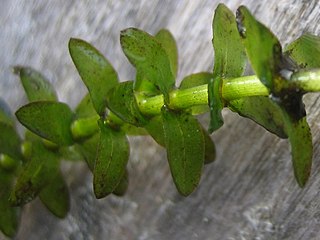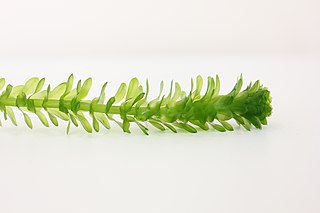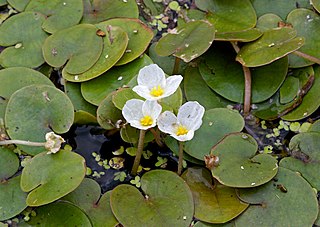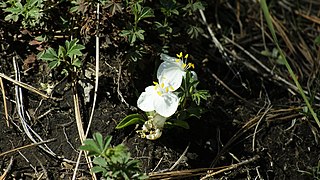
Elodea is a genus of 6 species of aquatic plants often called the waterweeds described as a genus in 1803. Classified in the frog’s-bit family (Hydrocharitaceae), Elodea is native to the Americas and is also widely used as aquarium vegetation and laboratory demonstrations of cellular activities. It lives in fresh water. An older name for this genus is Anacharis, which serves as a common name in North America.

Egeria is a genus of three species of aquatic plants in the family Hydrocharitaceae described as a genus in 1849. native to warm-temperate South America.

Vallisneria is a genus of freshwater aquatic plant, commonly called eelgrass, tape grass or vallis. The genus is widely distributed in tropical and subtropical regions of Asia, Africa, Europe, and North America.
Ophellantha is a genus of plants under the family Euphorbiaceae first described as a genus in 1924. It is native to southern Mexico and northern Central America.
- Ophellantha spinosaStandl. - Honduras, El Salvador, Chiapas, Veracruz
- Ophellantha steyermarkiiStandl. - Guatemala, Chiapas
Dalembertia is a plant genus of the family Euphorbiaceae first described as a genus in 1858. It is native to Mexico and Guatemala.
- Dalembertia hahnianaBaill. - México State, Morelos, Michoacán
- Dalembertia platanoidesBaill. - Oaxaca, Guerrero, México State
- Dalembertia populifoliaBaill. - from Sonora to Oaxaca
- Dalembertia triangularisMüll.Arg. - Guatemala, Chiapas, Oaxaca

Hydrocharis is a genus of aquatic plants in the family Hydrocharitaceae described as a genus by Carl Linnaeus in 1753. It is widespread across much of Europe and Asia, plus a few scattered locations in Africa. It is also reportedly naturalized in parts of North America.

Caldesia is a genus of aquatic plants. It includes three living species widespread across Europe, Asia, Africa and Australia. The genus "has an extensive Oligocene through Pleistocene fossil record in Eurasia," and has been found in fossil strata of the United States as well. Ten fossil species have been described for the genus.

Halodule is a genus of plants in the family Cymodoceaceae described as a genus in 1841. It is widespread on tropical and semi-tropical ocean shores of all continents except Europe and Antarctica.

Weldenia is a monotypic genus of flowering plant in the family Commelinaceae, first described in 1829. It has one single species: Weldenia candida, which grows originally in Mexico and Guatemala.

Nechamandra is a monotypic genus of an aquatic plant family Hydrocharitaceae. The sole species is Nechamandra alternifolia. It is found in slow moving fresh water.

Ottelia is a genus of an aquatic plant family Hydrocharitaceae described as a genus in 1805. The genus is native to tropical and subtropical regions of Africa, Asia, South America, and Australia.

Blyxa is a genus of an aquatic plant of the family Hydrocharitaceae described as a genus in 1806.
Najas filifolia, the needleleaf waternymph, is an aquatic plant in the Hydrocharitaceae. It is a rare and little-known species, known from only three counties (Decatur County, Georgia; Santa Rosa County, Florida; and Leon County, Florida. It is unusual in the genus in bearing fruits that are recurved to crescent-shaped.
Blyxa aubertii, common name bamboo plant, is a plant species widespread across Asia, Europe, Africa and Australia, but known from the Western Hemisphere only from a few collections in the southwestern part of the US State of Louisiana. This is an aquatic plant growing in shallow lakes and ponds. This and other species in the genus are sold commercially as greenery to grow alongside fish in aquaria.

Sagittaria platyphylla, the delta arrowhead, broad-leaf arrowhead or delta duck-potato, is a plant species native to the eastern United States. The core of its range extends from central Texas to the Florida Panhandle north to southern Illinois.

Najas gracillima, the slender waternymph, is a submerged species of aquatic plant in the Hydrocharitaceae family. found in lakes and streams. It is native to China, Russian Far East, Japan, Korea, Taiwan, Iran, Alberta, Ontario, Newfoundland, Nova Scotia, New Brunswick, the eastern United States. It is also considered introduced and naturalized in France, Spain, Italy and California.
Najas ancistrocarpa is a species of aquatic plant in the Hydrocharitaceae family. It grows in fresh water ponds and is a native to Japan (Honshu) and to parts of China.

Sagittaria guayanensis, the Guyanese arrowhead, is an aquatic plant species. It is predominantly tropical, native to Mexico, Central America, the West Indies, and much of South America, as well as West Africa, south and southeast Asia, plus Sudan and Madagascar. It was unknown in the United States until a few populations were reported from Louisiana in 1969.
Appertiella is a genus of an aquatic plant of the family Hydrocharitaceae described as a genus in 1982. There is only one known species, Appertiella hexandra, endemic to Madagascar.

Xyris jupicai, common name Richard's yelloweyed grass, is a New World species of flowering plants in the yellow-eyed-grass family. It is widespread in North America, South America, Mesoamerica, and the West Indies.














